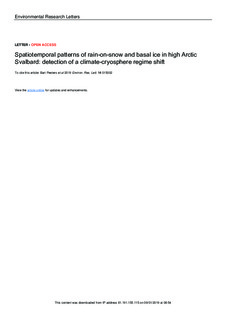| dc.contributor.author | Peeters, Bart | |
| dc.contributor.author | Pedersen, Åshild Ønvik | |
| dc.contributor.author | Loe, Leif Egil | |
| dc.contributor.author | Isaksen, Ketil | |
| dc.contributor.author | Veiberg, Vebjørn | |
| dc.contributor.author | Stien, Audun | |
| dc.contributor.author | Kohler, Jack | |
| dc.contributor.author | gallet, jean-charles | |
| dc.contributor.author | Aanes, Ronny | |
| dc.contributor.author | Hansen, Brage Bremset | |
| dc.date.accessioned | 2019-01-05T11:58:13Z | |
| dc.date.available | 2019-01-05T11:58:13Z | |
| dc.date.created | 2018-11-13T11:49:43Z | |
| dc.date.issued | 2018 | |
| dc.identifier.issn | 1748-9326 | |
| dc.identifier.uri | http://hdl.handle.net/11250/2579318 | |
| dc.description.abstract | Arctic winters have become increasingly warmer and rainier. Where permafrost prevails, winter rain (or rain-on-snow; ROS) is known to occasionally cause extensive ice layers at the snow/ground interface, i.e. "basal ice" or "ground-ice", with potentially large ecological and socio-economic implications. However, an overall lack of field data has so far restricted our predictive understanding of the environmental conditions shaping spatiotemporal variation in basal ice. Here, we use time-series of spatially replicated snowpack measurements from coastal (Ny-Ålesund area; 2000-2017) and central Spitsbergen (Nordenskiöld Land; 2010-2017), Svalbard, to analyze spatiotemporal patterns in basal ice and how they are linked with topography, weather, snowpack and climate change. As expected, both the spatial occurrence and thickness of basal ice increased strongly with the annual amount of winter rain. This effect was modified by accumulated snowfall; a deeper snowpack restricts ice formation following a minor rain event, but enhances ice formation following heavy rain due to an increased contribution of snowmelt. Accordingly, inter-annual variation in snow depth was negatively related to basal ice thickness. Annual fluctuations in basal ice thickness were strongly correlated in space (average correlation ρ = 0.40; 0-142 km distance between plots) due to strong spatial correlation in winter rain (ρ = 0.62; 14-410 km distance between meteorological stations). Models of basal ice based on meteorological time-series (1957-2017) suggested that ice-free winters (i.e. mean basal ice < 0.1 cm) had virtually not occurred since 1998, whereas such winters previously (1957-1998) occurred every three-four years on average. This detected cryosphere regime shift was linked to a parallel climate regime shift with increased winter rain amounts. Svalbard is regarded a bellwether for Arctic winter climate change. Our empirical study may therefore provide an early warning of future changes in high-arctic snowpacks. | nb_NO |
| dc.language.iso | eng | nb_NO |
| dc.publisher | IOP | nb_NO |
| dc.rights | Navngivelse 4.0 Internasjonal | * |
| dc.rights.uri | http://creativecommons.org/licenses/by/4.0/deed.no | * |
| dc.title | Spatiotemporal patterns of rain-on-snow and basal ice in high Arctic Svalbard: detection of a climate-cryosphere regime shift | nb_NO |
| dc.type | Journal article | nb_NO |
| dc.type | Peer reviewed | nb_NO |
| dc.description.version | publishedVersion | nb_NO |
| dc.source.journal | Environmental Research Letters | nb_NO |
| dc.identifier.doi | 10.1088/1748-9326/aaefb3 | |
| dc.identifier.cristin | 1629874 | |
| dc.relation.project | Svalbards miljøvernfond: 16/113 | nb_NO |
| dc.relation.project | Norges forskningsråd: 244647 | nb_NO |
| dc.relation.project | Norges forskningsråd: 269758 | nb_NO |
| dc.relation.project | Norges forskningsråd: 223257 | nb_NO |
| dc.relation.project | Svalbards miljøvernfond: 13/74 | nb_NO |
| dc.relation.project | Norges forskningsråd: 276080 | nb_NO |
| dc.description.localcode | © 2019 The Author(s). Published by IOP Publishing Ltd under a CC BY 3.0 licence. | nb_NO |
| cristin.unitcode | 194,66,10,0 | |
| cristin.unitname | Institutt for biologi | |
| cristin.ispublished | true | |
| cristin.fulltext | postprint | |
| cristin.qualitycode | 1 | |

